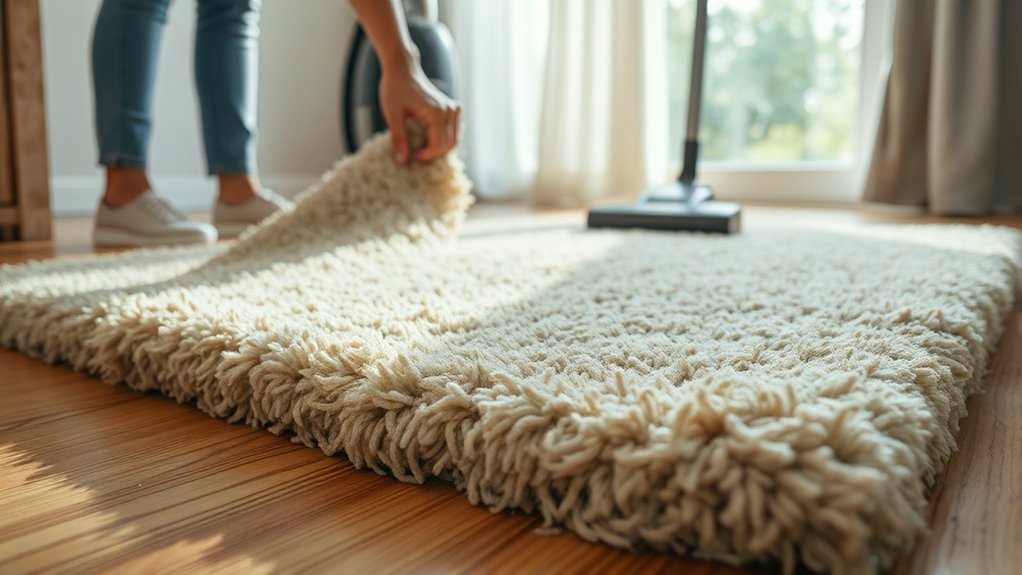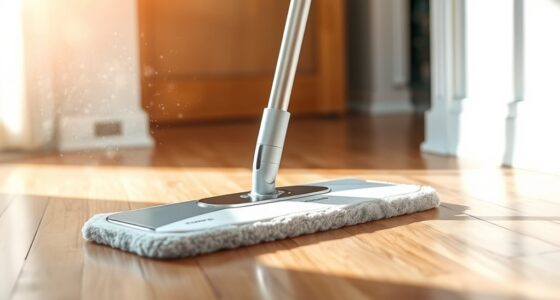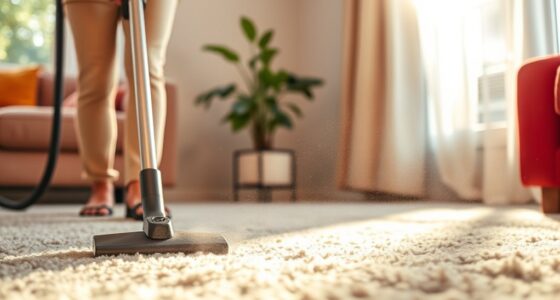Removing carpets can dramatically lower indoor allergens like dust mites, pet dander, and pollen, helping you breathe easier and reducing allergy symptoms. Hard surfaces such as hardwood or tile are easier to clean regularly, which keeps dust and pet hair at bay. However, switching from carpets may cost more initially and impact your home’s coziness. If you want to explore the full benefits and potential drawbacks, there’s more to contemplate that can help you make an informed choice.
Key Takeaways
- Removing carpets reduces allergen buildup, making it easier to maintain a cleaner, allergy-friendly home environment.
- Hard floors like hardwood and tile do not trap dust mites, pet dander, or pollen as carpets do.
- Easier cleaning methods such as sweeping and mopping lower the need for deep cleaning and allergen accumulation.
- Hardwood and tile floors can enhance home aesthetics and may increase property value.
- Regular maintenance with HEPA-filter vacuums and air purifiers further improves allergy relief on hard surfaces.

If you’re struggling with allergies, removing carpets from your home can make a considerable difference. Carpets tend to trap dust mites, pet dander, pollen, and other allergens, which can worsen allergy symptoms. Switching to hardwood surfaces or tile not only reduces allergen buildup but also makes cleaning easier. However, many people opt for alternative floor coverings like area rugs, which can add warmth and style to a room while still being manageable from an allergy perspective. If you choose to keep area rugs, make sure you clean them regularly with a vacuum equipped with a HEPA filter to prevent allergens from becoming airborne. Hardwood surfaces are particularly beneficial because they don’t trap allergens like carpets do. They are easier to wipe clean, which means less dust and pet hair lingering in your living space. Plus, hardwood floors don’t require deep cleaning as frequently as carpets, reducing the overall allergen load in your home. When removing carpets, you’ll want to think about the impact on your decor. Hardwood floors can be a sleek, modern choice that complements various styles, and they often increase your home’s value. On the other hand, some may worry about the durability of hardwood or the cost of installation. Nevertheless, the health benefits often outweigh these concerns, especially if allergy symptoms are severe. If you decide to install new flooring, be mindful of the materials you choose; some woods are better suited for allergy sufferers because they don’t off-gas volatile organic compounds (VOCs). Maintaining a clean, allergen-free environment involves more than just removing carpets. Regularly sweeping and mopping hardwood surfaces helps keep dust and dander at bay. Using a damp mop or microfiber cloth can trap more allergens than sweeping alone. Additionally, investing in an air purifier with a HEPA filter can further reduce airborne allergens, making your home safer and more comfortable. Furthermore, considering the integration of modern smart cleaning technologies, such as robotic vacuums with HEPA filters, can significantly enhance allergen control in your home. Switching from carpets to hardwood surfaces or carefully chosen area rugs requires some effort, but many find the improvement in their allergy symptoms well worth it. You’ll notice less sneezing, fewer itchy eyes, and easier breathing. While it might involve some initial expense and effort, the long-term benefits of a cleaner, allergen-reduced environment can greatly boost your overall comfort and health. Remember, the key is consistent cleaning and choosing the right flooring and decor options to suit your needs, making your home a healthier place to breathe.
Frequently Asked Questions
Are There Alternative Flooring Options to Reduce Allergies?
Yes, you can choose allergy-friendly flooring options like hardwood alternatives, laminate, vinyl, or tile. These surfaces don’t trap dust, pet dander, or mold like carpets do, making them ideal for allergy sufferers. When selecting allergy-friendly flooring, consider durability and ease of cleaning. Switching to these options can markedly reduce allergens in your home, improving indoor air quality and helping you breathe easier every day.
How Long Does It Take to See Allergy Improvements After Removal?
You’ll typically notice allergy symptom improvements within a few days to a few weeks after removing carpets. The allergy symptom timeline varies depending on your sensitivities and cleaning habits, but most see a positive impact within 2 to 8 weeks. The removal impact duration depends on how well you clean the area afterward; consistent vacuuming and air purification can speed up relief. Stay patient, and you’ll likely experience fewer allergy triggers soon.
Can Cleaning Carpets Effectively Eliminate Allergens?
Cleaning carpets can help with allergen removal, but it might not fully eliminate all allergens. Regular vacuuming with HEPA filters and professional deep cleaning are effective allergen removal techniques that boost carpet allergy prevention. However, some allergens like dust mites and pet dander may persist despite cleaning. For ideal allergy relief, consider removing carpets altogether or combine cleaning with other measures like air purifiers and dust-mite covers.
What Are the Costs Associated With Replacing Carpets?
Replacing carpets can feel like investing in a fresh start, and costs vary based on material, size, and installation complexity. You might spend anywhere from a few hundred to several thousand dollars, including carpet installation and flooring maintenance. Keep in mind, choosing quality materials and proper installation can save you money long-term, reducing upkeep and extending the life of your new flooring. Budget accordingly for a smooth changeover.
Are There Health Risks During the Carpet Removal Process?
Yes, there are health risks during carpet removal. You might be exposed to dust mites and mold spores, which can trigger allergy or asthma symptoms. During the process, it’s important to wear protective gear like masks and gloves to minimize inhalation of allergens. Proper ventilation and thorough cleaning afterward help reduce lingering allergens, ensuring a safer environment for you and your family.
Conclusion
Removing carpets can considerably reduce indoor allergens, helping you breathe easier and lessen allergy symptoms. While some worry about the cost or aesthetics, the benefits often outweigh these concerns. Did you know that carpets trap dust mites and pet dander, contributing to 60% of indoor allergies? By switching to hard flooring, you create a cleaner environment that promotes better health. Ultimately, taking this step could make a noticeable difference in your allergy relief and overall comfort.









